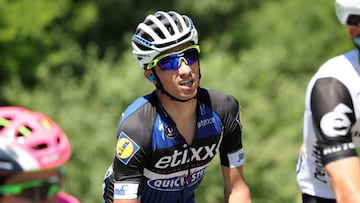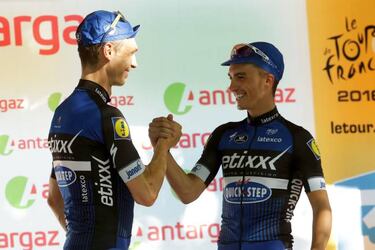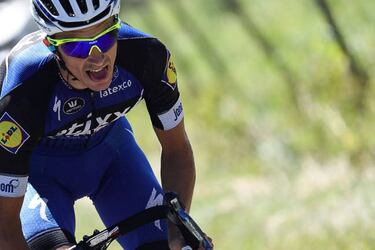Alaphilippe: "I want to win a great Ardennes classic"
The young French rider is lighting up the Tour de France with his trademark attacks and hopes to go on to great things after this year's race.

After a decade in the shadows, France has begun producing world-class riders again – and Julian Alaphilippe is one of the country's brightest diamonds.
Post-Armstrong era
At the forefront of the fight against doping after revelations of widespread abuse in the Festina scandal in 1998, France struggled in the Lance Armstrong era. But the implementation of the biological passport in 2008, which helped curb doping abuses, opened the door to the new breed of riders born in the 1990s.
Thibaut Pinot took third place overall in the 2014 Tour de France; Romain Bardet already had two top-10 finishes in the world's biggest race, and Warren Barguil has also been tipped as a potential future Tour winner, while sprint specialist Arnaud Demarre claimed the Milan-San Remo classic, one of the five "Monument" classics this season.
The youngest of the lot, the laid-back Alaphilippe, 24, took second place in two other Monuments, in the Fleche Wallonne and Liege-Bastogne-Liege classics last year, before winning the week-long Tour of California this season, prompting his Etixx-Quick Step team to send him to the Tour de France.
White jersey
Alaphilippe did not disappoint, wearing the white jersey in the first week and coming at one stage within a few seconds of taking the coveted yellow jersey.
Most notably, Alaphilippe, one of the punchiest riders in the peloton, at ease in the short and brutal climbs -- much less so on long ascents -- was deprived of a possible stage win last week when he lost considerable ground because of a mechanical problem while leading in the final descent of the 15th stage.

Two days earlier, a strong gust of wind had blown him into the rocky cliffside during the individual time trial. The photograph became a worldwide hit on social networks, and despite the scare Alaphilippe got back on his bike and finished the stage.
"Several riders came to see me and asked me if I used Photoshop, but I didn't," Alaphilippe told Reuters in an interview on the second rest day of the Tour, less than 24 hours after his day-long breakaway with team mate Tony Martin.
"I saw the stone wall and one second later I crashed on to it. I was turned over like a pancake," he smiled. "But I had to get back on my bike. After the Nice attack, I was not going to complain. People had lost members of their family and I was going to say that my arm was hurting?".
Bold attacks
Alaphilippe never complains. He's happy to be on the Tour, where he "learns every day", lighting up a sometimes boring race with his bold attacks.
"I follow my instincts," he says. During the race and at training, too, where unlike almost all his colleagues in the professional peloton, he does not look at his power metre. "We have in the team very efficient devices but I must admit I don't use them much. I'm not against it -- I know it helps. But I'm a bit old school."
Unlike most French riders, who are well protected in French teams, Alaphilippe turned professional in a foreign team, Belgium-based Etixx-Quick Step, where he rides with three-times time-trial world champion Martin or multiple-Tour stage winner Marcel Kittel.

"This image of grain-fed riders, it's nice, but sometimes you have to kick yourself in the ass," says Alaphilippe, who was never offered a contract in France.
A young man with his feet firmly on the ground, the flying Frenchman does not believe he can win the Tour because he is not the sort who can succeed in grand-tour events, but he certainly does not lack ambition.
"I want to win a classic"
"I want to win a great Ardennes classic," he says, referring to spring races like Liege-Bastogne-Liege or the Fleche Wallonne.
Related stories
But he might not have to wait until next year to celebrate, as he will be one of the favourites to win the Olympics road race in Rio next month.
"For the moment, I don't want to think about it," he said. "I must finish the Tour first."